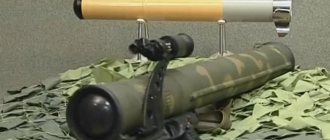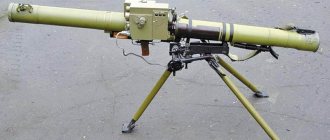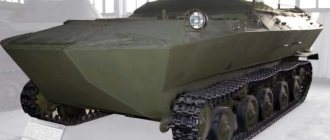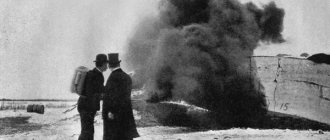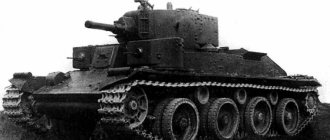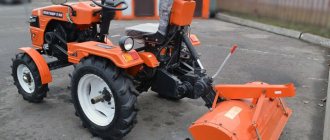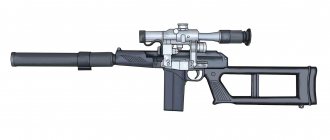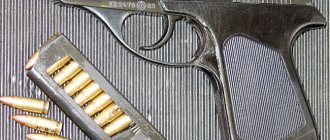This term has other meanings, see Bumblebee (meanings).
| Bumblebee | |
| missile index 3M6 , NATO designation AT-1A Snipper | |
| 3M6 "Bumblebee" on display at the Central Museum of the Armed Forces, Moscow. | |
| Type | anti-tank missile system |
| Status | withdrawn from service |
| Developer | OKB-16 |
| Chief designer | A. E. Nudelman |
| Start of testing | April 1958 |
| Adoption | August 1, 1960 |
| Manufacturer | |
| Years of production | 1961-1966 |
| Years of use | 1960-? |
| Main operators | USSR army |
| Other operators | |
| Modifications | 2Q15 2Q16 |
| ↓All technical specifications | |
| Images on Wikimedia Commons | |
"Bumblebee"
(missile index -
3M6
, according to the classification of the US Department of Defense and NATO:
AT-1A
Snapper - Soviet anti-tank missile system of the first generation. Developed at OKB-16 under the leadership of A.E. Nudelman. Adopted by the USSR Armed Forces on August 1, 1960. Serial production complex lasted from 1961 to 1966.
Designed
to destroy tanks, engineering and fortifications, and surface targets
.
Served as the basis for further developments
.
Modifications
The ATGM was placed on two types of ground-based carriers:
- 2K15 "Shmel"
- an anti-tank missile system with a 2P26 combat vehicle based on the chassis of a GAZ-69 all-terrain vehicle with four rail-type guides located in the rear of the body. In service since 1960. - 2K16 “Bumblebee”
is an anti-tank missile system with a 2P27 combat vehicle based on the chassis of a BRDM combat reconnaissance and patrol vehicle (
GAZ-40P
) with three pop-up rail guides located in an armored wheelhouse. In service since 1964.
According to the organizational structure, combat vehicles were consolidated into anti-tank batteries assigned to motorized rifle regiments. Each battery had three platoons with three 2P26 and 2P27 launchers and a platoon commander's BRDM in each.
The flight speed of a bumblebee and its small perfect wings
The bumblebee belongs to the order of Hymenoptera insects. The bee family is real. There are about 300 species in the genus Bombus. They live all over the Earth. Even in cold latitudes: they live in Greenland, on Novaya Zemlya, on the Chukotka Peninsula. They warm up by working the pectoral muscles, while humming. There are mountain views. There are fewer representatives of the genus near the equator. Not long ago, these insects were brought to Australia. They do not make long-distance flights themselves. Representatives of the genus Bombus are considered hardy insects, but the bumblebee's flight speed is low.
Combat use
Known cases of using the Shmel ATGM:
- Egyptian operators hit at least 10 Israeli tanks during the Six-Day War.
- A few months after the end of the 1967 war, the Egyptians managed to hit two Israeli M48 tanks patrolling the eastern bank of the Suez Canal with a Bumblebee ATGM.[1]
- The Greek Cypriots used the Bumblebee ATGM during the 1974 Turkish invasion. Several targets were hit, for example, on August 1, a Turkish M47 tank was destroyed by a 3M6 missile.[2][3][4][5][6][7][8]
Bumblebee insect. Bumblebee lifestyle and habitat
A bumblebee is an insect that belongs to the species of true bees. They can be considered close relatives of honey bees. They are considered warm-blooded insects, since when moving their body releases a large amount of heat, and the temperature reaches 40 degrees. They are the largest representatives of the family.
The body of the bumblebee is densely pubescent, which allows it to adapt even to harsh conditions. The color of bumblebees can be different, it depends on their habitat. The eyes are not covered with villi and are located in a straight line. The body length of the insect can reach 3.5 centimeters.
The male is distinguished from the rest by his long mustache. Bumblebees almost never sting; only females have a sting. Hairy bumblebees or moss bees are very useful insects. They are general pollinators. Developing great speed, they rush from flower to flower. Their nests must be protected!
Moss bumblebee
There are two most common types of bumblebees:
- Bombus terrestris;
- Bombus lap >Habitat and lifestyle of bumblebees
Bumblebees are distributed throughout the world except Australia and Antarctica. They can often be found throughout Europe and Africa. Depending on their habitat, bumblebees develop new habits.
Bombus terrestris live mainly in Africa. They are black in color with white segments on the abdomen. Externally, it is difficult to distinguish females and males in this species. The largest are the uteri and reach a size of up to 3 centimeters. Bumblebee nest being built in the ground by workers
Bombus lapidarius is a well-known species that is distributed throughout Europe. They are all black, but have bright red stripes on the belly. They grow about 2 centimeters in length. These bumblebees often get into trouble. Often female parasites use these furry creatures as food for their larvae. This type of bumblebee builds its nests with stones.
Bumblebees are designed in such a way that they live in families and are divided into:
Although these insects have a social division, it is not as pronounced as in other Hymenoptera. As a rule, in bumblebees the division of labor between males and workers is not particularly pronounced. The queen, of course, is only concerned with nesting and raising offspring.
The photo shows a bumblebee's nest
Communication between all individuals passes through the nest and the uterus. But their connections cannot be called stable. Bumblebees calmly leave their nests and queen. Often the queen and the main male sit on the nest in the morning and begin to make strange sounds. Thus, the female calls all her charges and actually wakes them up.
A bumblebee's nest can be of various shapes, and the cells are made sloppily. They are made from moss and wax. Bumblebees often use mouse holes to build nests. Sometimes you can find honey and flower dust in them.
All summer long, the female bumblebee lays fertilized eggs. They hatch into workers and females. Most often, several eggs are laid in one cell. Not all larvae survive!
Only those with enough food will survive. The larvae develop for about two weeks and then become pupae. They remain in this state for about 14 more days. While the female lays eggs, workers collect nectar and lay unfertilized eggs, which will later become males.
The bumblebee community is usually about 500 individuals. After the eggs hatch, the old queens die and are replaced by new ones. By winter, the community dies out and scatters completely, leaving only the queens.
Notes
- [www.waronline.org/IDF/Articles/firstATGM.htm#AT-3 First generation ATGM in the IDF]
- Cyprus 1974 – The Greek coup and the Turkish invasion, Makarios Drousiotis, Hellenic Distribution Agency
- Armor in Cyprus, Evolution and Action. Ioannis Mamounidakis. 2008
- Savvas D. Vlassis, O Aporritos Attilas, Athens 2004
- OPERATION “NIKI” 1974 – A Suicide Mission to Cyprus. (Mikhail Solanakis)
- Battle of Nicosia International Airport – Cyprus 1974 by a Greek Commando, Published Istoria (History), 1993
- The Action of the Captured M47 in Attila II in The Unknown Soldier of Cyprus (Savvas Vlassis)
- Georgiou P.Sergi - “Battle for Cyprus. July–August 1974", Athens 1999 (in Greek)
- ↑ 12345678910
ATGMs of the Ground Forces / ed. Dmitrieva G.N. - Kyiv: Archive-Press, 1997. - P. 26. - 26 p. — (Archive 500+). — 700 copies.
Primus pump repair
In the pump, first of all, the rubber piston ring and the check valve gasket (less often) fail. Of course, you can try to find the originals, but lately there are fewer and fewer of them. Therefore, I propose to upgrade the pump. Modernization consists of replacing the rubber ring with a leather cuff.
Primus pump: 20—cylinder; 21—rod; 22—pump ring; 23—nut; 24—wing nut; 25—spring; 26 — tip; 27—valve piston; 28—check valve gasket; 29—piston ring; 30—washer.
- First, we disassemble the pump and remove the factory washers from the rod with pliers. One of the washers will be useful to us later.
- On the rod we cut a thread of 6 mm with a length of 10 - 11 mm
- On the old washer, we expand the hole to 6 mm, take a 6 nut and grind its edges down to 8-9 mm, while making it round. (see picture).
- Next, we make a leather cuff. The skin must be selected on one side, fleecy, 2 mm thick. For example, a boot top.
- Cut a circle with a diameter of 21-22 mm in the center, make a hole with a diameter of 6 mm, and lower the skin into water to soak it. Next, let's give it the desired shape.
- We take the pump body, push the leather cuff into the body with the fleecy side outward, so that the leather goes completely inside the pump. It is better to push with a drill or rod with a diameter of 10 mm. Then we leave the skin in the pump to dry.
- After the leather has dried, we will have a leather cap with a hole (cuff).
- We screw a narrow 6 mm nut onto the rod, put a counterbored washer or a new one, put on a leather cap and tighten the round nut that we ground off earlier. Lubricate the cuff with machine oil. We assemble the pump and enjoy the working pump.
It is important here that the diameter of the outer washer is larger than the diameter of the inner nut. When the pump pumps, the outer washer props up the cuff, thereby compressing the air. On the return stroke, the inner (small nut) allows the cuff to fold towards the center and allow air into the pump.
If after a while the pump begins to pump worse, moisten the cuff in oil.
cut the thread on the rod
outer round nut, collar, washer, nut
new pump design
primus pump bumblebee
Links
- www.shmel.org/gallery/324/
- waronline.org/IDF/Articles/firstATGM.htm#AT-3
| This is a preliminary article about weapons. You can help the project by adding to it. |
| This is a draft article about missile weapons. You can help the project by adding to it. |
| Self-propelled | "Phalanx" • "Bumblebee" |
| Artillery | "Centimeter" • "Daredevil" |
| Aviation | "Phalanga-N" |
| Second generation | |
| Portable | “Bassoon” • “Metis”/“Metis-M” • “Cornet” |
| Self-propelled | “Konkurs”/“Konkurs-M” • “Chrysanthemum” • “Sturm-S” |
| Artillery | “Kastet” • “Krasnopol” • “Gran” • “Kitolov” |
| Aviation | “Sturm-V” • “Attack-V” • “Whirlwind” • “Threat” |
| Tank | "Dragon" • Bastion • "Sheksna" • "Fable" • "Cobra" • "Reflex"/"Reflex-M" • "Invar"/"Invar-M" • "Svir" • “Arkan” • “Zenith” • “Rupture” • “Falcon-1” |
| Third generation | |
| Portable | "Autonomy" • "Kornet-MR" |
| Self-propelled | "Hermes" • "Cornet-LR" |
| Artillery | "Beta" • "Firn-1" |
| Aviation | "Hermes-A" |
| Tank | • |
| Slot machines | HK MP5 • Zastava M21 • Zastava M70 • Zastava M77B1 • Zastava M80 • Zastava M85 • Zastava M90 • Zastava M92 |
| Machine guns | Zastava M02 "Coyote" • Zastava M72 • Zastava M77 • Zastava M84 • Zastava M87 |
| Sniper rifles | Zastava M07 • Zastava M76 • Zastava M91 • Zastava M93 “Crna strela” |
| Grenade launchers | Zastava M93 • M-80 “Zola” • M-79 “Osa” • M-90 “Strshlen” |
| ATGM | 9M14 “Malyutka” • 9K111 “Bassoon” • 3M6 “Bumblebee” • “Bumbar” |
| Artillery | M74 mortar • M75 mortar • M46 cannon • D30 howitzer • M84 “Nora” howitzer • 2S1 “Gvozdika” self-propelled gun • B52 “Nora” self-propelled gun • SVLR M94 “Plamen-S” • SVLR M77 “Ogan” • SVLR M87 “Orkan” |
| Air defense systems | 40 mm L/70 “Bofors” • LPRS 9K310 “Igla” • LPRS 9K32M “Strela-2M” • RS 9P31M “Strela-1” • RS 9K35M “Strela-10M” |
| Cars | UAZ-469 • Pinzgauer 710M • Puch 300 • Land Rover • TAM 80 • TAM 110 • TAM 150 • TAM 5000 • FAP 1118 • FAP 2228 • FAP 2026 • FAP 2632 • ZIL-131 |
| Armored vehicles | BOV M86 • BOV M83 • BRDM-2 • BTR-50 • BVP M80 • T-72 • M-84 • M-84AS • Lazar • VIU-55 “Muya” |
An excerpt characterizing the 3M6 “Bumblebee”
Rostov remembered at that moment a strange conversation he once had with Dolokhov. “Only fools can play for luck,” Dolokhov said then. – Or are you afraid to play with me? - Dolokhov said now, as if he had guessed Rostov’s thought, and smiled. Because of his smile, Rostov saw in him the mood of spirit that he had during dinner at the club and in general at those times when, as if bored with daily life, Dolokhov felt the need to get out of it in some strange, mostly cruel, act . Rostov felt awkward; he searched and did not find a joke in his mind that would respond to Dolokhov’s words. But before he could do this, Dolokhov, looking straight into Rostov’s face, slowly and deliberately, so that everyone could hear, said to him: “Do you remember, we talked to you about the game... a fool who wants to play for luck.” ; I probably should play, but I want to try. “Try for luck, or perhaps?” thought Rostov. “And it’s better not to play,” he added, and cracking the torn deck, he added: “Bank, gentlemen!” Moving the money forward, Dolokhov prepared to throw. Rostov sat down next to him and did not play at first. Dolokhov glanced at him. - Why don’t you play? - said Dolokhov. And strangely, Nikolai felt the need to take a card, put a small jackpot on it and start the game. “I have no money with me,” said Rostov. - I’ll believe it! Rostov bet 5 rubles on the card and lost, bet again and lost again. Dolokhov killed, that is, he won ten cards in a row from Rostov. “Gentlemen,” he said, after spending some time, “please put money on the cards, otherwise I might get confused in the accounts.” One player said he hoped he could be trusted. – I can believe it, but I’m afraid of getting confused; “Please put money on the cards,” Dolokhov answered. “Don’t be shy, we’ll get even with you,” he added to Rostov. The game continued: the footman, without ceasing, served champagne. All Rostov's cards were broken, and up to 800 tons of rubles were written on him. He was about to write 800 thousand rubles on one card, but while he was being served champagne, he changed his mind and wrote the usual jackpot again, twenty rubles. “Leave it,” said Dolokhov, although he did not seem to look at Rostov, “you’ll get even sooner.” I give to others, but I beat you. Or are you afraid of me? - he repeated. Rostov obeyed, left the written 800 and placed the seven of hearts with a torn off corner, which he picked up from the ground. He remembered her well afterwards. He placed the seven of hearts, writing 800 above it with a broken piece of chalk, in round, straight numbers; drank the served glass of warmed champagne, smiled at Dolokhov’s words, and with bated breath, waiting for the seven, began to look at Dolokhov’s hands holding the deck. Winning or losing this seven of hearts meant a lot for Rostov. On Sunday last week, Count Ilya Andreich gave his son 2,000 rubles, and he, who never liked to talk about financial difficulties, told him that this money was the last one until May, and that is why he asked his son to be more economical this time. Nikolai said that this was too much for him, and that he gave his word of honor not to take any more money until spring. Now 1,200 rubles of this money remained. Therefore, the seven of hearts meant not only a loss of 1,600 rubles, but also the need to change this word. With a sinking heart, he looked at Dolokhov’s hands and thought: “Well, quickly, give me this card, and I’ll take my cap, go home to dinner with Denisov, Natasha and Sonya, and I’ll certainly never have a card in my hands.” At that moment, his home life, jokes with Petya, conversations with Sonya, duets with Natasha, a picket with his father, and even a calm bed in the Cook's house, presented themselves to him with such strength, clarity and charm, as if all this were long past, lost and priceless happiness. He could not allow that a stupid accident, forcing the seven to lie first on the right than on the left, could deprive him of all this newly understood, newly illuminated happiness and plunge him into the abyss of an as yet unexperienced and uncertain misfortune. This could not be, but he still waited with bated breath for the movement of Dolokhov’s hands. These broad-boned, reddish hands with hair visible from under the shirt, put down a deck of cards, and took hold of the glass and pipe being served. - So you're not afraid to play with me? - Dolokhov repeated, and, as if in order to tell a funny story, he put down the cards, leaned back in his chair and slowly began to tell with a smile: - Yes, gentlemen, I was told that there was a rumor in Moscow that I was a card sharper, so I advise you to be careful with me. - Well, swords! - said Rostov. - Oh, Moscow aunties! - said Dolokhov and took up the cards with a smile. - Aaah! – Rostov almost shouted, raising both hands to his hair. The seven he needed was already at the top, the first card in the deck. He lost more than he could pay.
"Bumblebee" stings with lightning speed
“JSC High-Precision Complexes will continue to improve its unique family of flamethrowers
In the modern world, with its high urbanization and a significant percentage of the population living in cities and metropolitan areas, battles in urban environments are becoming commonplace. Suffice it to recall the two assaults on Grozny in 1994 and 1999, Baghdad in 2003, Fallujah in 2004, recent clashes in Libyan Misurata in 2011 and in Syrian Deraa and Aleppo in 2012–2013. Therefore, the military departments of the developed countries of the world pay special attention to the development of effective weapons and military equipment for urban combat.
Organizing and conducting an assault on a populated area is one of the most difficult types of combat at the tactical and operational levels. According to Western and domestic military experts, an important role in the successful capture and clearing of it is played by the preparedness of the personnel of the assault units and subunits, as well as their equipment and weapons. Rich experience in this area was accumulated by the Soviet Army during the Great Patriotic War. The experience of fighting in Stalingrad, Koenigsberg, Berlin, etc. formed the basis of methodological manuals and combat manuals of the army not only of the Soviet/Russian army, but also of Germany, France and even the USA.
“When we were preparing to storm Grozny in the winter of 1999, we asked for all the documents and manuals on the battles in Stalingrad. They helped us a lot,” Colonel General Vladimir Bulgakov, Hero of Russia, told the Military-Industrial Courier newspaper. But in the modern world, with its high level of information and new technologies, the tactics of storming cities and towns have undergone significant changes.
In urban combat
Since 2001, American military scientific institutions, including the US Army War College, have published several dozen scientific works analyzing the experience of armies of various countries in storming cities. In 2006, the US Army issued field regulations FM 3-06 Urban Operations, regulating operations in urban areas, and in 2008 – FM 2-91.4 Intelligence Support To Urban Operations, dedicated to organizing intelligence in cities and towns.
“Weapon systems are constantly being improved, new solutions and developments are appearing. RPO “Shmel” does not stand still either.”
The main feature of urban combat is that the opponents are in close proximity to each other.
“One house was occupied by my units, and across the road from them there were militants. That's why I didn't call the air force. The militants are close, and the pilots can cover their own, and if we retreat to a safe distance, the enemy will occupy the positions we left. Therefore, the Su-24 and Su-25 worked much further according to the plan of the higher command,” Hero of Russia Colonel Evgeniy Kukarin, who commanded the troops of the Vostok group that stormed Grozny in December 1999, told a VPK correspondent.
At the same time, it will not be possible to knock out the enemy from houses and buildings with small arms and mortars alone, which are often not inferior in strength to long-term reinforced concrete fortifications. Therefore, direct fire artillery and tanks are actively used in battle.
During the Great Patriotic War, in the divisions that stormed cities and towns, due to the losses incurred, there were from four to seven rifle battalions - only 150-200 active bayonets, but many guns and mortars. Each division had approximately a hundred guns, reinforced by army, corps artillery regiments and reserve brigades of the main command. At least two or three mechanized and tank corps with hundreds of tanks each took part in the battles in Konigsberg, Budapest and other cities, and in the Berlin operation there were even tank armies. True, without infantry, tanks and other armored vehicles in urban areas are vulnerable to enemy grenade launcher fire, as the bloody assault on Grozny in the winter of 1994 proved. The tanks of the 131st motorized rifle brigade and the 81st motorized rifle regiment, with weak support from infantry and artillery, were blocked and quickly knocked out. But already in the winter of 1999, when storming Grozny for the second time, the Russian command limited the use of armored vehicles, but artillery fire was much more intense. According to Evgeniy Kukarin, during the assault on Grozny’s Minutka Square he was supported not only by several 152-mm self-propelled howitzers, but also by heavy 240-mm “Tulip” mortars that used adjustable mines.
The US Army and Marine Corps actively used artillery and armored vehicles when they stormed Iraqi cities in 2003–2005. But like Russian troops in Chechnya, the US military was faced with the high vulnerability of tanks and infantry fighting vehicles, even despite the excellent training and numerical superiority of its infantrymen. It is noteworthy that, unlike the Russian military, the US Army and Marine Corps prefer to fire artillery at targets distant from their positions, and aviation with high-precision weapons must destroy the enemy in close proximity to ground troops. Although, as the experience of battles in Iraqi Fallujah, Nasiriyah, etc. shows, more than 70 percent of airstrikes were canceled due to the proximity of militants to the positions of American units.
Despite different approaches and technical equipment, when storming cities, the armed forces of Russia and the United States face similar problems. The enemy is located several tens of meters from the positions of Russian (American) troops in buildings that protect from small arms and mortars, which, however, can be destroyed by artillery fire, tanks and air strikes. But more than half of the strikes are canceled due to the threat of hitting friendly units.
As the experience of the Russian and American military shows, if it is impossible to destroy the enemy with long-range fire weapons and armored vehicles directly in the house, units storm the buildings, clearing it from the basement to the roof.
“I advanced in a solid line. If at least one assault group broke out one house further, then the militants could easily surround it and cut it off. So they cleared one house after another,” Colonel Yevgeny Kukarin told a journalist from the Military-Industrial Courier newspaper.
For such sweeps, the assaulting infantry must have enough firepower to overwhelm the enemy. It must be taken into account that the task of the defenders is to inflict maximum damage to the troops attacking them in manpower and armored vehicles. In Chechnya and Iraq, militants did not try to defend populated areas. Their goal was a negative response in the media caused by heavy losses among the attackers. Suffice it to recall the New Year's assault on Grozny.
The most profitable scenario for militants is when, due to the inability to use artillery, aviation and armored vehicles, troops are forced to storm every house, and their losses can amount to hundreds of people. This is where the so-called pocket artillery comes to the aid of the troops, or, more simply put, grenade launchers, flamethrowers and especially effective thermobaric charges, capable of destroying the enemy holed up in houses, basements and various buildings in close fire combat without losses from the attackers.
Following the results of urban battles in 2003–2006 in Iraq, the US Army returned the Swedish Carl Gustav and M-79 grenade launchers, which had already been removed from service, to infantry companies, and the Marine Corps hastily ordered thermobaric charges that had proven themselves in two assaults on the city of Fallujah for regular SMAW grenade launcher.
Surprisingly, back in the 90s, American military experts were skeptical about thermobaric ammunition for grenade launchers, considering them ineffective. At the same time, the Soviet army, back in the late 70s, appreciated the advantage of such ammunition, adopting flamethrowers of the RPO “Shmel” family, which showed their high efficiency in Afghanistan, Tajikistan, and the first and second Chechen wars.
"Lynx" in Afghanistan
During the Second World War, a flamethrower created in the early 1900s was highly effective in clearing and storming urban buildings. The fuel mixture, placed under pressure in special tanks, was thrown towards the enemy and set on fire. Having performed well in the trenches of the “positional nightmare” of the First World War, the flamethrower was adopted by chemical and engineering units of countries around the world who stormed engineering structures and buildings during the Spanish Civil War, the battles at Khalkhin Gol and during the Second World War. The Soviet, German, British and American ground forces had special flamethrower units, which were assigned to reinforce regular rifle (infantry) companies and battalions that stormed cities and towns. Despite all their effectiveness, flamethrowing devices had several drawbacks that significantly complicated their use. This is a large weight of incendiary cylinders, often reaching up to 20 kilograms. The mixture itself was enough for a few seconds of work, and when fragments or bullets hit the cylinders, the flamethrower turned into a pillar of fire, burning not only itself, but also the soldiers surrounding it within a radius of 10–15 meters. It is noteworthy that both the Allied and Axis countries were armed with not only hand-held flamethrowers, but also flamethrowers mounted on tanks and armored vehicles.
Classic flamethrowers reached the Vietnam War, where they were successfully used by the US Army and Marine Corps both in clearing jungles and in battles in the South Vietnamese city of Hue during the Tet Offensive. The Soviet Union realized the futility of such products and began searching for their replacement back in the early 50s. In 1976, the first flamethrowers “Lynx” developed by the Tula Instrument Engineering Design Bureau entered service with the flamethrower battalions of the radiation, chemical and biological defense forces (RKhBZ) of the Soviet army. The newest product, created using the components and mechanisms of the RPG-16 hand-held rocket launcher, fired a four-kilogram incendiary charge over a hundred meters and could destroy not only buildings and engineering fortifications, but also light armored vehicles. For the first time in battle, the Lynx was used by Soviet troops in Afghanistan, but expectations from the weapon were not fully met. With a length of almost one and a half meters, the flamethrower itself with additional charges weighed more than 20 kilograms, and the incendiary mixture turned out to be ineffective in rocky mountain conditions. The Lynx charges could not always set fire to the stone and adobe houses of local residents. It is noteworthy that the weak incendiary capabilities of the flamethrower mixture of both the classic Soviet flamethrower LPO-50 and the rocket-propelled "Lynx" against modern brick and panel buildings were known to the commands of the Ground Forces and the RCBZ troops of the Soviet Army from the experience of exercises in the late 70s. It turned out that the primitive buildings of the inhabitants of Afghanistan withstand the blow of the fire mixture more effectively than modern buildings.
“Soviet troops and their Warsaw Pact allies were preparing to conduct military operations against NATO countries in the highly urbanized territory of Western Europe. The task was not to clear the cities, but to break through them, destroying the enemy blocking units. Therefore, separate flamethrower battalions were formed as part of the RKhBZ troops, which were ordinary motorized rifle battalions, but additionally armed with Lynxes, and later with Bumblebees. The engineering and sapper units had a large amount of equipment capable of destroying rubble and barricades in narrow streets,” Vitaly Moiseev, editor-in-chief of the Internet project “Courage 2004,” explained to the Military-Industrial Courier newspaper.
"Bumblebee" comes into position
To replace the outdated Lynx and LPO-50, the instrument design bureau began developing a fundamentally new flamethrower with a thermobaric warhead in the late 70s.
Thermobaric explosion, often called volumetric, has been known to scientists for a long time. A flammable substance is sprayed into the air in the form of an aerosol, and the resulting gas cloud is set on fire. The explosion is accompanied by a strong shock wave and excess pressure. According to this principle, fires occurred in mills in the past, where clouds of dust formed during the grinding of flour exploded. The aerosol tends to “flow” into buildings, rooms and various shelters, so it will not be possible to hide behind the wall of a building, in a trench, pillbox, etc. The explosion will reach there too. True, a volumetric explosion is more effective in closed spaces than in open areas, where the aerosol can disperse too quickly.
Soviet and American specialists began experiments with thermobaric ammunition back in the 60s. The first volumetric explosion munitions were used by the US Air Force during the Vietnam War, where they proved their high destructive power in the closed space of the jungle.
In the 70–80s in the West, thermobaric ammunition followed the path of increasing power due to the weight of the aerosol and the caliber of the ammunition itself. But only the Tula Instrument Engineering Design Bureau realized the high efficiency of volumetric explosion ammunition for urban combat, starting in 1984 the development of the Shmel rocket-propelled infantry flamethrower. The designers paid great attention to summarizing the unsuccessful Afghan experience in using the Lynx and decided to make the Bumblebee disposable and light enough to make it easier for soldiers to carry and store in armored vehicles. The compact RPO container, which is more than half a meter shorter than the Lynx, turned out to be more convenient to handle in cramped urban spaces. A four-kilogram ammunition placed in a container was ejected by a powder charge installed in the engine over a thousand meters and destroyed enemy fortifications and manpower within a radius of 80 square meters in closed areas and in buildings and 50 meters in open space.
Even before being put into service in 1988, the Bumblebees underwent military testing not only at training grounds in the Group of Soviet Forces in Germany, but also in the 40th Army fighting in Afghanistan, where they were used in the mountains and during assaults and clearing of villages. One “Bumblebee” charge was enough to completely destroy a two- or three-story stone house, not to mention an adobe one (which the “Lynx” could not do). According to calculations carried out by the Main Rocket and Artillery Directorate of the Soviet Army, the power of the Bumblebee ammunition is equal to a 107-mm high-explosive projectile, however, without explaining which howitzer or cannon.
In publications of the 80s devoted to the weapons of the Soviet army, American experts spoke extremely negatively about the newest flamethrower, pointing out the weakness of the charge, low power and a high threat to civilians. “Bumblebee” fit very well into the ongoing propaganda campaign about the atrocities of the Soviet army in Afghanistan. But within 20 years, such charges will take their place in the arsenals of units of the US Army and Marine Corps.
“Losing weight”, but became more effective
RPO "Shmel" had to fight a lot. But in all wars and military conflicts, the flamethrower received only positive reviews.
“We could not suppress the firing point of the “spirits.” A two-story brick building with loopholes in the walls. They shoot from the PK (Kalashnikov machine gun. – Note by “VPK”) and AK. Even our sniper cannot get the “spirits”. The fighters with the Bumblebee approached and rolled a charge into one of the windows. The house crumbled and sank before our eyes,” an officer from the special forces unit of the Russian Ministry of Internal Affairs shared his memories of the fighting in Chechnya with a journalist from the Military-Industrial Courier. And there are more than enough such memories of combatants.
| RPO PDM-A "Shmel-M" |
Weapon systems are constantly being improved, new solutions and developments are appearing. “Bumblebee” doesn’t stand still either. Despite all the positive qualities of the flamethrower, the military has complaints about the sighting devices. On the one hand, complex sights for a disposable “Bumblebee” are an unnecessary luxury, but on the other hand, for long-range shooting you still need a special sight. With a maximum firing range of a thousand meters, you can only really hit the target effectively when the target is 200 meters away.
In the early 2000s, the modernized Shmel-M flamethrower, also known under two indices - RPO-M and RPO PMD-A, entered service with the Russian Army. The newest flamethrower has “lost weight” by almost five kilograms compared to the conventional “Bumblebee”, but the effective range has increased to 300 meters, and the maximum to almost one and a half kilometers. The Shmel-M kit includes the so-called reusable fire control complex - a set of optical, night, and, more recently, thermal imaging sights, which are removed after the shot and installed on the following containers. There is also a special sight that can be combined with the eyepieces of a regular night vision scope. If the "Shmel" was essentially a dynamo-reactive flamethrower, then the "Shmel-M" became completely reactive, since the charge is thrown towards the target by a jet engine without a powder charge. But the main thing in the updated flamethrower is the new fuel mixture, thanks to which the power of the ammunition has increased many times over. Now, according to expert calculations, the RPO-M charge is superior to a 122-mm high-explosive projectile and is equal to a 152-mm projectile from a 2S19 MSTA-S self-propelled howitzer.
The armies of the developed countries of the world do not yet have similar flamethrowers in service. In terms of performance characteristics, the American reusable SMAW grenade launcher with a thermobaric warhead, which has been in service with the US Marine Corps since 1984, is close to the Shmel and Shmel-M. While superior to the RPO family in terms of firing range, the charge of the American-Israeli grenade launcher is several times inferior to the Russian family in power; also, when equipped, the one and a half meter SMAW is very inconvenient to carry in urban combat conditions. It is not for nothing that the American Marines prefer to load it at the last moment, which requires almost a minute for a trained crew. During that time, you can shoot three or four Bumblebees.
Now the US military prefers portable thermobaric charges installed in buildings. Relatively lightweight, they are not inferior in power to the Bumblebee charges. But their placement is associated with a certain risk, since they have to be placed under fire and it is not always possible to perform all the necessary actions. The book by American special forces officer Mark Owen, “Not an Easy Day,” describes a case when, during a night assault on a building in Baghdad, Delta operators, faced with strong resistance, decided to use a portable thermobaric projectile. But the Delta fighter setting the charge forgot to set the fuse and had to return under fire from Iraqi militants to fix the problem. But these were trained soldiers of an elite special forces unit, one of the best in the world.
The Tula Instrument Engineering Design Bureau, part of the holding company, has developed and is constantly improving a unique family of flamethrowers. Today, when High-Precision Complexes celebrates its fifth anniversary, I would like to wish all its employees not to stop there, but to continue to produce unique weapons systems and military equipment that are superior to the best Western models.
Alexey Ramm
Published in issue No. 7 (525) on February 26, 2014
